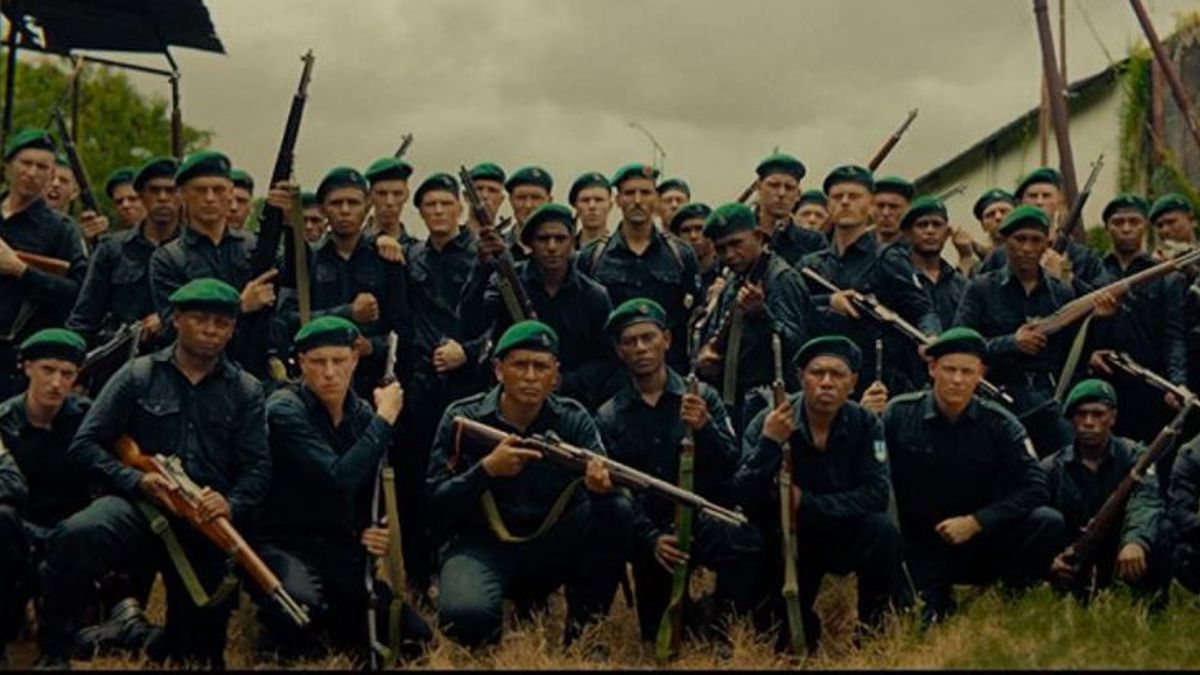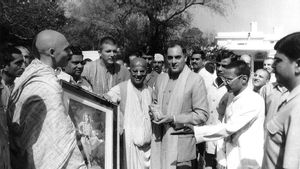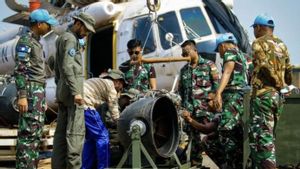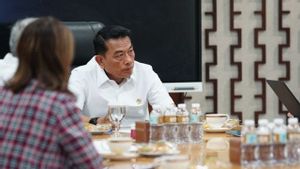
JAKARTA - Less than two weeks after its first release in the Netherlands, May 13, 2021, the film De Oost immediately attracted a lively response in the Land of the Windmills. Contradictions emerge from this film.
Palmyra Westerling, daughter of Raymond Westerling (1919–1987) strongly rejected the depiction of her father's cruelty in Sulawesi as shown in the film. In addition, the voices of the KNIL veterans - the Dutch East Indies army - did not show satisfaction.
Both felt that the film had presented a narrative that cornered the operation of the Dutch army in Indonesia during the revolutionary period (1945–1949), which until the last few decades was seen by the Dutch public as an operation to restore the "rust en orde" in the Indies.
This view has now been refuted thanks to research work carried out by a group of researchers from the Institute for War, Holocaust and Genocide Research (NIOD); the Dutch Institute of Military History (NIMH); and the Royal Institute for Humanities Research (KITLV).
But the researchers who have opened a new perspective for history also seem to have their own record for the film De Oost. Historians such as Anne van Mourik and Roel Frakking have criticized how Dutch "good intentions" were portrayed as a central element in the film.
They warned that the picture is very likely to produce a misleading picture of what the Dutch army actually did. In that framework, military operations in Indonesia have the potential to be seen as “good intentions that get out of hand”.
And thus impressing the Indonesian side as the guilty party. The heated discussion left the question of how the film was actually viewed in Indonesia? Until now, on June 9, 2021, De Oost has attracted little attention.
In part, this is due to Amazon not releasing the film in Indonesia. However, several well-known media such as Tirto and Kompas have published their articles about this film. Very likely, De Oost will not be received as gently in Indonesia as Palmyra Westerling had anticipated.
However, the skeptical view of the historical narrative made by the Dutch -which has always been seen as a former colonizer - is evident in the Indonesian public. Thus, suspicion, critical views, and perhaps rejection will inevitably arise.
New horizons
But when we put aside these sentiments, what value can we really take from sitting for 2 hours and 17 minutes watching De Oost? For the younger generation of Indonesia, there is a knowledge gap that has been successfully filled, but there is also something that the film has left gaping.
If this film is intended for audiences in Indonesia, there is a lot of information and understanding that can be taken by the public. In particular, the film's point of view which is placed on the side of the colonialists can provide a picture that the Indonesian public has never paid attention to.
I watched the film with my fiancé—a generation that in Indonesia is often described as millennial: in our twenties and growing up after Suharto's fall in 1998, a generation with laptops and smartphones in our hands.
However, my fiancé—like most of our generation in Indonesia—is not familiar with the historical episodes that De Oost shows. Wasn't 1945 the year of independence? Why did the Dutch still come and stay in Indonesia one year later?
This is a reasonable question in a country where history studies in schools are so narrow that history becomes so foreign when even the slightest veil of the veil is attempted to be lifted.
A liberation mission
In the film, we are invited to explore the tragic life of a volunteer soldier, Johan de Vries, who went to the Indies/Indonesia shortly after Soekarno's proclamation of independence was read. On Johan's shoulders, there is a burden and pressure to serve the country in exchange for the political orientation of his father who is an NSB (National-Socialist Movement, a pro-Nazi organization in the Netherlands).
He himself believed that he was enlisting on a noble mission to help a nation in turmoil within itself at the hands of Japan's propagandist fascist rulers. Seeing this "noble mission" argument, my fiancé immediately asked, "They (the Dutch) feel they are protecting and want to free Indonesians, is it true that there were Indonesians who at that time wanted to be protected and released?".
This question did not come from a void. Throughout the short history lessons received at school, the curriculum simply revealed that the Indonesians after independence united and united against the Dutch colonialists.
However, when we are confronted, among other things, in the letter dated October 7, 1944, from village heads in Loloda, North Maluku which was received by a NICA (Dutch East Indies Civil Administration) commander below, perhaps we will be able to understand where the Dutch people's thoughts came from about the "good intentions," it comes from. One snippet of the letter reads:
[…] but we do not forget and (we remember) the love of our former government, namely the Dutch government (which) was like father and mother because as long as we lived (under the Netherlands) we were happy and at peace together -ever.
There are many more statements like this and sometimes they remind us of the reality in Indonesia today when people from the older generation talk about the Soeharto dictatorship era (President of Indonesia, 1968–1998).
Usually, we will find a nostalgic expression next to the smiling general: Piye kabare? Enak jamanku to? (How are you doing? My regime was better, right?).
Even the suffix “to (toch)” is a colonial legacy. Likewise, there are still many people in East Germany who feel the same way about the old communist government: peace and silence without worries if we act well.
Therefore, in fact, the response to Dutch colonialism was different in Indonesia. However, the educated generation in Indonesia rarely touches historical sources and does not know much deeper than what the government teaches through their school curricula at the primary and secondary levels.
An alternative perspective
De Oost has started a very important discussion in a way that appeals to young people. The Indonesian curriculum focuses entirely on efforts to awaken nationalism, not on increasing critical power in viewing history, as is now the norm in Dutch education.
Thus, history is often depicted in two colors: black-and-white, right-wrong, red-and-white. This is unfortunate because a thorough understanding of historical phenomena will actually lead to critical thinking and maturity in the state. The history of Indonesia that is now taught only creates a feeling that Indonesia has been looted and oppressed for centuries by foreign nations.
Very few people know that there is a series of reasons that underlie the cruel acts of the Dutch, which in the current curriculum seem as if the Dutch purely wanted to torture Indonesians. De Oost lifts the curtain of this delusion in a few minutes because it shows something that Indonesians rarely know, namely a different perspective.
It depicts footage of the condition of the post-war Netherlands, the result of the Nazi occupation of Dutch citizens, and finally a picture of the Dutch army which is not just a killing machine. Here, the demonic figure of the invader suddenly takes on the form of human-like other humans.
So, what is really interesting about understanding the colonial point of view? This film will certainly not arouse sympathy but instead triggers a lot of questions and discussions. There the Dutch are depicted as cruel parties, but their actions have reasons, although sometimes they are described in a flat and unattractive manner.
Indonesia actually has an advantage here because by portraying the Dutch as a ruthless enemy, Indonesia takes on the role of a victim. However, the Dutch acknowledgment and apology for the war, booty, and slavery operations they had carried out had put the Netherlands at a higher moral level than its former colonies, which constantly pretended that Indonesian history itself consisted solely of actions. - an act of heroic struggle.
Johan de Vries' own good intentions are a good example—albeit a bit vague—of the typical Dutch apology and guilt attempt: he was wrong, but he admitted his guilt and thus ended up putting himself as a victim in this war. The 'Turk' (Westerling) finally tempts him to commit suicide in the last scene.
The Dutch government often makes such apologies: by closing the book on its old mistakes, it manifests itself as the birthplace of international peace and justice in the 21st century. And now we face the fact that colonialism and slavery in the world economy have taken different forms.
These differences include economic inequality, corrupt oligarchs, modern slavery, human trafficking, blunt justice, etc., with results very similar to those experienced by Indonesians during colonialism.
Therefore, even with the best of intentions, colonialism cannot be seen as better than genocide as the Germans did to the Jews, the Turks to the Armenians, as well as the Americans to the Native Americans and African slaves. Also, in today's world, we see the politics of apartheid happening to the Palestinians in Israel and the forced assimilation of the Uyghurs in China.
In the long term, perpetrators often become victims, but victims also often end up becoming perpetrators. Seen from this point of view, efforts to prevent future colonialistic actions are already a noble goal—because the repetition of colonialism models is unfortunately still common.
However, repairing or healing the wounds of atrocities that occurred in the past is a clearly impossible goal. A motorcyclist who kills a mother certainly has to pay compensation, but this does not heal the child from trauma and grief. The Republic of Indonesia in this regard is not the best example of acting—and unlike the Netherlands, the Indonesian government is still allergic to apologies.
Therefore, we ourselves can find Indonesia in the news as a neo-colonial party against areas such as East Timor, Aceh, Ambon, and Papua. However, De Oost has pulled Indonesia out of its historiographical comfort zone by creating an alternative narrative to the history of the struggle for independence. The colonial perspective can be used as a reflective material so that Indonesia is not innocently trapped in the colonial mentality.

In addition to the colonial perspective, De Oost reveals how several Indonesian individuals view their identity. In one of the most controversial snippets, Johan asked a soldier from Ambon, Samuel, about how he felt 'against his own nation' to which he replied “they are not my people, your people (the Netherlands) make us one country”.
This sheds light on the understanding that even after independence there were still Indonesians who did not feel they were one nation. In the face of Indonesian education, this reality should be given an extensive understanding, instead of being buried under the national historical narrative. The public must understand that national identity is something that is fought for and does not just appear.
The struggle for identity appears interestingly in various parties, as depicted in other footage of the film. There, there was a scene of a fight between Indonesian-KNIL soldiers and Dutch volunteer soldiers at a bar in the port city of Semarang, then a strong royalist base in the Indies.
Things got out of control when a Dutch soldier insulted Queen Wilhelmina (1890–1948) after losing a friend to a bullet while crossing a river in the interior of Java. Unexpectedly, the Ambon KNIL soldier was furious because he felt that his “queen” had been insulted.
This episode may come as a shock to the Indonesian public, but it is a factual fact that shows that some colonial subjects were a plus royaliste que le roi or, in other words, more patriotic in red, white, and blue (the color of the Dutch flag) than the Dutch people themselves.
As noted by historian, Ong Hok Ham, in Runtuhnya Hindia Belanda (1989), Indonesians may hate the colonial government, but they respect the Queen of the Netherlands. Unfortunately, the unique footage in the film doesn't come with any explanation even though the director himself comes from the Ambonese KNIL family.
Open Archive Box
Snippets like that are pieces of information that can fill the gaps in knowledge that exist in the minds of the younger generation in Indonesia —who now understand more about the ins and outs of Korean pop music than how Indonesia used to be. Exposure to such information at least gives a new perspective even if the film fails to present a broader historical narrative.
However, the appeal of the film is in the actions of the actors, historical information can certainly be found outside the film with the availability of wide access at this time. For example, I am currently working with Koninklijke Bibliotheek (KB, National Library of the Netherlands) to develop an artificial intelligence (AI)-based search engine that can identify and search for entries in Indonesian newspapers on the Delpher page.
With the rapid development of such efforts, the Indonesian public will soon be able to easily access Dutch or Malay language newspapers and search for content such as names of people, places, and events. Thus, alternative stories such as in the film De Oost can be searched for historical truth and one can explore that history is not just a battle between heroes and villains.
With this, readers can determine for themselves what they want to look for, not just hearing what they are dictated to. With digital searches, topics that have never been discussed in either the Netherlands or Indonesia can be revealed.
For example, the beta version of our search engine has managed to find the fact that part of the Dutch cabinet in exile had approved and recognized an autonomous Indonesian federation in June 1945—two months before Sukarno's proclamation of independence was read.
This decision was taken after a group of bright Indonesian students crossed the English Channel from Rotterdam and Leiden just after Dutch Independence Day to demand the independence of their homeland—as Queen Wilhelimina had promised in a famous radio address on December 6, 1942. The leader of this student group was a Leiden alumnus, Zairin Zain (1913–1974), who later also played an important role as ambassador in Washington (in office, 1961–1965) during the 1965 power struggle.
However, his name later disappeared from the history books for no apparent reason. The socialist colonial ministers readily agreed to Zairin's request, as did the progressive Lieutenant Governor-General of the Dutch East Indies, Hubertus van Mook (1894–1965). Unfortunately, the Catholic People's Party (KVK, founded December 22, 1945) represented by one of its founders, Louis Beel (1902–1977) showed resistance to this idea.
The controversial politician from Limburg—who is actually an educated man but shares his views with the extreme right politician Geert Wilders (born 1963)—let the war heat up when he served as prime minister (served, 1946–1948). He allowed Van Mook to act as executor, a role that brought great horror within him and even led to the fatal defeat of his general, Simon Spoor (1902–1949).
Westerling could easily be considered a war criminal and this is clearly how he is shown in history lessons in Indonesia. In addition to his massacres in Celebes (Sulawesi) in 1946 and 1947, he also carried out a coup with his own hands in January 1950. However, the policy-making of officials in The Hague is also highly questionable and is rarely a concern. The film De Oost even shows very few Indies officials and their performances are only for a few seconds.
If we take a closer look at high-level policy-making in The Hague, the bloodshed in Indonesia could have been avoided. Beel was trusted by Queen Wilhelmina to rebuild the Netherlands from the chaos caused by the German occupation, but he himself had violently destroyed Indonesia.
Ironically, one of the figures who contributed to stopping this violence was one of the groups of students mentioned above who had come to the Dutch government to ask for independence, Soemitro Djojohadikoesoemo (1917–2001).
He convinced the United States government under President Harry S. Truman (1884–1972) in 1948 to withdraw Marshall Aid from the Netherlands if the country did not stop its bloody operations in Indonesia. In December 1945, Soemitro once wrote to the mother of a college friend who had helped him hide in 1943 in a remote village in Drenthe:
“I still have faith in the Dutch government and have the spirit of friendship. But soon, very soon, my trust must be respected. And when I find that people still intend to use us [Indonesia] as a toy, the [Dutch] government will surely find me one of its toughest opponents. However, let's hope that never happens".
Had conservative politicians as Beel listened to these things three years earlier, the episode in history would have been different. Thus, there are still many veils that can be revealed about this period. However, to unravel it, curiosity must first be aroused and De Oost has done it wonderfully.
National history?

KNIL soldiers in Tapanuli on the 40th anniversary of Queen Wilhelmina's reign (Source: KITLV Leiden)
Therefore, we should hope that Amazon will decide to make De Oost available to audiences in Indonesia. Who knows, the film will eventually open up a wider horizon than just a nationalistic history because it is precisely this kind of national history that has for centuries legitimized the Dutch presence in the archipelago.
Apart from that hope, after watching the film to the end, there is actually a big gaping knowledge hole: where is the explanation or picture from the side of the national movement or community groups that are pro-independence Indonesia? If the film is intended for Indonesian audiences, of course, the views of Soekarno's group and friends no longer need to be presented because the public has consumed it from an early age.
However, if the film is aimed at a wider audience, the silent voices of pro-independence Indonesians in the film will give the misleading impression that they may indeed be a terrorist group who are even ready to chop off people's heads and stuff the victim's genitals into his body's mouth.
This narrative from the pro-independence Indonesian side is the gaping knowledge hole left by Jim Taihutu and his friends in De Oost. If only Indonesian films or other works could be released and could overturn the now dominant western version of history. The literary works of Multatuli and Kartini did approach this effort, but they even became prominent because they were encouraged by Dutch activists.
In fact, technological advances have made it possible for Dutch and Indonesians alike to make their own films and it would be nice if those films could be screened in one marathon so that they could be discussed across borders through online spaces. This week, this dream has become even closer.
Talented director from Indonesia, Mouly Surya (born 1980) —known through Marlina, Pembunuh Dalam Empat Babak (2017) — will begin adapting the novel Jalan Tak Ada Ujung by renowned author Mochtar Lubis (1922–2004). This kind of international work will quickly show that everyone actually has a part to play in a war.
*This article is a contribution from VOI.ID readers
About the Author:
Christopher Reinhart is a history researcher who is currently working with Koninklijke Bibliotheek (National Library of the Netherlands) in developing artificial intelligence (AI)-based search engine for Indonesian (Malay) and Dutch language publications from 1930 to 1957. He was also an assistant researcher from Prof. Peter Carey (Oxford Fellow Emeritus, now Visiting Professor at the Faculty of Humanities, University of Indonesia) and one of the coordinators of the online Reading Room on Geger Pacinan 1741–1743 under Satya Wacana Christian University. Can be contacted by email: [email protected].
The English, Chinese, Japanese, Arabic, and French versions are automatically generated by the AI. So there may still be inaccuracies in translating, please always see Indonesian as our main language. (system supported by DigitalSiber.id)









